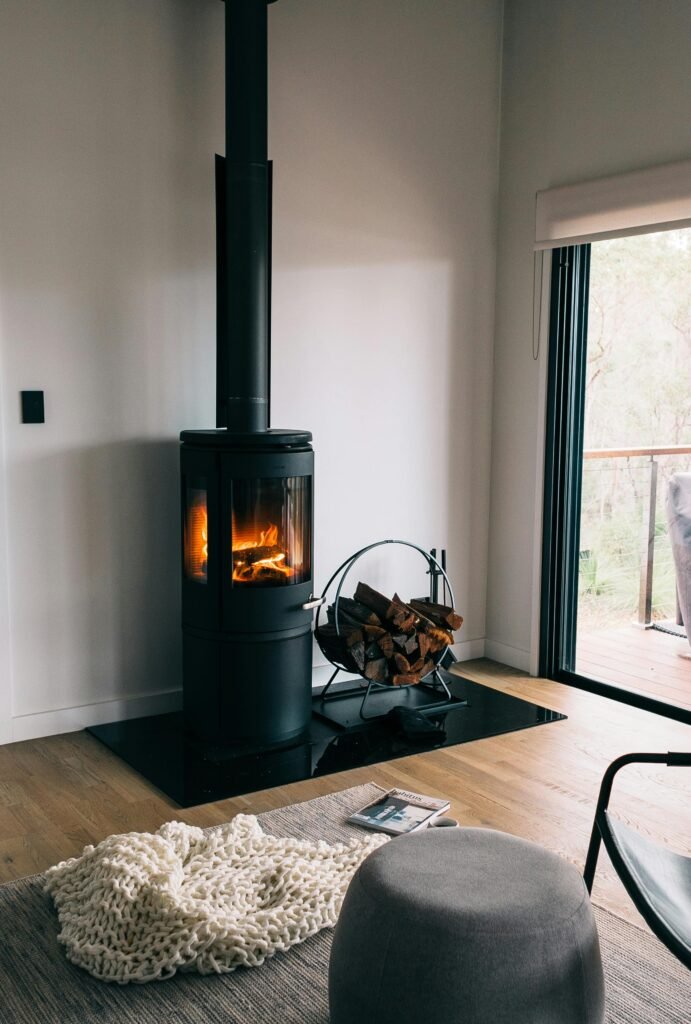Imagine a cozy winter evening, sitting by the crackling fireplace, sipping hot cocoa and enjoying the warmth. Sounds perfect, right? Well, to ensure that this peaceful scenario doesn’t turn into a nightmare, it is important to integrate fireplace safety into your daily routines. With a little mindfulness, you can enjoy the comfort of a fireplace while ensuring the safety and well-being of yourself and your loved ones. In this article, we will explore some simple yet essential fireplace safety tips that you can easily incorporate into your daily lives. So, kick back, relax, and let’s dive into the world of fireplace safety!
Buy Fireplace Safety Products Here
1. Understanding the Importance of Fireplace Safety
Fireplaces can be a wonderful addition to any home, providing warmth and ambiance during the colder months. However, it is essential to prioritize safety when using a fireplace. Understanding the importance of fireplace safety is crucial to protect yourself, your loved ones, and your property from potential hazards.
1.1 Fire Hazards Associated with Fireplaces
One of the most significant risks associated with fireplaces is the potential for fire hazards. When a fire is burning, there is an increased chance of sparks flying out of the fireplace and igniting nearby combustible materials such as curtains, furniture, or carpets. Creosote buildup, a black and sticky substance that accumulates in chimneys, is another fire hazard that can lead to chimney fires.
1.2 Potential Risks to Household Members
Fireplaces also pose potential risks to household members. Burns from direct contact with hot surfaces are a common concern, especially for children and pets who may not understand the dangers. Inhaling smoke and toxic gases, such as carbon monoxide, can also result in serious health issues. It is crucial to address these risks and take necessary precautions to ensure the safety of everyone in the household.
1.3 Impact on Property and Home Insurance
Neglecting fireplace safety measures can have significant financial implications. In the event of a fire caused by a fireplace, the damage to your property can be extensive, leading to costly repairs or even complete loss. Moreover, many home insurance policies require homeowners to adhere to specific fireplace safety guidelines. Failure to comply with these guidelines could result in a denial of coverage or increased premiums. By prioritizing fireplace safety, you can mitigate potential risks and protect your property and home insurance coverage.
2. Establishing Safe Fireplace Practices
To ensure the safe operation of your fireplace, it is essential to establish and maintain safe practices. By following these practices, you can minimize the risks associated with fireplaces and enjoy the warmth and beauty they bring to your home.
2.1 Regular Fireplace Maintenance and Inspection
Regular maintenance and inspection are fundamental to fireplace safety. It is crucial to have your chimney professionally cleaned and inspected at least once a year to remove any creosote buildup and identify any potential issues. Additionally, it is important to regularly clean the fireplace opening, chimney cap, and any other components to prevent debris and blockages that could hinder proper airflow.
2.2 Safe Fireplace Installation
Proper installation of your fireplace is of utmost importance to ensure its safe operation. When installing a fireplace, it is recommended to consult with a professional who can ensure the correct placement, ventilation, and compliance with safety regulations. Faulty installations can lead to increased fire hazards, improper smoke ventilation, and compromised structural integrity.
2.3 Proper Disposal of Ashes and Embers
The disposal of ashes and embers requires careful attention to avoid potential fires. It is crucial to wait at least 24 hours after the fire has completely extinguished before removing ashes from the fireplace. Once cooled, ashes should be placed in a metal container specifically designed for ash disposal and stored away from flammable materials. Avoid disposing of ashes in plastic containers or near combustible areas to prevent unintentional fires.

This image is property of images.pexels.com.
Get Your Fireplace Safety Essentials Now
3. Educating Household Members about Fireplace Safety
Educating all members of the household about fireplace safety is essential to ensure everyone understands the potential risks and knows how to act responsibly around the fireplace.
3.1 Teaching Children about Fire Safety
Children are naturally curious, and it is crucial to teach them about the dangers of fireplaces from an early age. Start by explaining the importance of not touching the fireplace or its surroundings when it is in use. Emphasize the need to stay a safe distance away and never throw anything into the fire. Teach them to identify and respect fire safety boundaries, both indoors and outdoors.
3.2 Instructing Adults on Fireplace Safety Guidelines
Adults in the household should have a thorough understanding of fireplace safety guidelines to lead by example and ensure safe practices. This includes educating them about proper fire starting techniques, monitoring the fire, and adhering to recommended guidelines for fireplace use. Share information on the importance of regular maintenance and inspection, as well as the safe handling and storage of firewood.
3.3 Communication and Practice of Emergency Procedures
To ensure everyone is prepared for emergencies, establish clear communication and practice emergency procedures. Develop an evacuation plan that includes a designated meeting point outside the home in case of a fire. Teach household members how to use fire extinguishers properly, and ensure everyone knows when to call emergency services. Regularly practice fire drills to reinforce proper procedures and familiarize everyone with the evacuation plan.
4. Creating a Fire-Safe Environment
Creating a fire-safe environment around your fireplace is essential for minimizing potential fire hazards and protecting your home and loved ones.
4.1 Clearing Combustible Materials and Decorative Items
Remove any flammable materials such as curtains, furniture, or decorations from the area surrounding the fireplace. Keeping a clear space of at least three feet around the fireplace reduces the risk of accidental ignition and ensures that sparks or embers have a safe distance to dissipate. Avoid placing highly flammable items, such as Christmas trees or paper decorations, in close proximity to the fireplace.
4.2 Installing Fire Guards and Protective Screens
Install fire guards and protective screens in front of the fireplace to prevent sparks, embers, or logs from rolling out onto the floor. These safety features act as a barrier between the fire and the surrounding area, reducing the risk of accidental fires or burns. Ensure that the guards and screens are securely in place and do not obstruct the ventilation of the fireplace.
4.3 Maintaining Adequate Ventilation
Proper ventilation is crucial for fireplace safety. Ensure that the chimney and flue are clear of any blockages and functioning correctly. Adequate ventilation allows for the safe expulsion of smoke, gases, and sparks, reducing the risk of a build-up of dangerous substances. Regularly check and clean the chimney cap, vents, and flue to maintain optimal ventilation and prevent potential hazards.

This image is property of images.pexels.com.
5. Safe Firewood Handling and Storage
Using and storing firewood safely is essential for both the performance of your fireplace and the prevention of fire hazards.
5.1 Choosing Seasoned and Dry Firewood
When selecting firewood, it is important to choose seasoned and dry wood. Seasoned firewood is wood that has been cut and dried for a period of six to twelve months, reducing its moisture content. Avoid using freshly cut or green wood as it contains a higher moisture content, leading to increased smoke production and the potential for creosote buildup in the chimney. Dry firewood ignites more efficiently, produces less smoke, and minimizes the risk of chimney fires.
5.2 Proper Firewood Storage and Placement
Proper storage and placement of firewood is necessary to prevent fire hazards and maintain its quality. Stack firewood outdoors and away from the house, ideally on a raised platform or rack to keep it off the ground and minimize contact with moisture. Avoid stacking firewood directly against the house or near the fireplace, as this can attract pests and increase the risk of accidental fires. Create a safe distance between the firewood stack and the house to reduce fire hazards.
5.3 Handling and Transporting Firewood Safely
When handling and transporting firewood, it is essential to do so safely. Wear protective gloves to protect your hands from splinters and use proper lifting techniques to avoid strain or injury. Use a sturdy wheelbarrow or cart to transport firewood, ensuring that the load is secure and balanced. Be cautious when moving firewood indoors, checking for any critters that may have nested in the wood.
6. Using Fireplace Tools and Accessories Correctly
Proper use of fireplace tools and accessories ensures the safe and efficient operation of your fireplace.
6.1 Recommended Tools for Fireplace Operation
A set of recommended tools for fireplace operation includes a poker, shovel, ash brush, and tongs. These tools enable you to safely adjust the logs, remove ashes, and maintain the cleanliness of the fireplace. Use the poker to rearrange burning logs and the shovel to remove ashes and debris. The ash brush helps sweep away loose ashes, while the tongs allow for the safe handling of burning materials.
6.2 Proper Handling of Fire Starters and Kindling
Fire starters and kindling are crucial for starting a fire safely. Use approved fire starters, such as suitable fire starter logs or chips, rather than flammable liquids or materials. Follow the manufacturer’s instructions when using fire starters and kindling, ensuring that they are appropriately placed within the fireplace to avoid flare-ups or unexpected fires. Keep flammable materials, such as newspapers or cardboard, away from the fireplace when using fire starters.
6.3 Safe Use of Fireplace Accessories
Additional fireplace accessories, such as log holders, fire-resistant hearth rugs, and heat-resistant gloves, can enhance safety and convenience. Use a log holder to secure the logs and prevent them from rolling out of the fireplace. Place a fire-resistant hearth rug in front of the fireplace to protect the floor from sparks or embers. When operating the fireplace, wear heat-resistant gloves to protect your hands when adjusting logs or handling hot tools.

This image is property of images.pexels.com.
7. Practicing Fire Safety During Fireplace Use
Practicing fire safety measures while using your fireplace is crucial for preventing accidents and promoting a safe environment.
7.1 Maintaining a Clear Area around the Fireplace
Always ensure there is a clear area around the fireplace, free from any flammable materials or obstructions. Keep furniture, rugs, drapes, and other combustible materials a safe distance away from the fireplace. Clear clutter from the hearth, ensuring that no items are stored or left in close proximity to the fire. Creating a clear area around the fireplace reduces the risk of accidental fires and allows for safe movement and operation.
7.2 Monitoring the Fire and Obeying Recommended Guidelines
When using a fireplace, it is crucial to closely monitor the fire and adhere to recommended guidelines. Never leave a fire unattended, especially when there are children or pets present. It is important to maintain a moderate fire, avoiding overly large fires that can cause excessive heat buildup or embers that may escape. Obey the recommended guidelines for firewood amount and proper positioning of logs to ensure optimal and safe combustion.
7.3 Extinguishing a Fire Safely and Properly
To extinguish a fire safely and properly, it is essential to follow a few key steps. Start by removing any unburned logs or debris from the fireplace using fireplace tools. Use the ash shovel to carefully scoop out the ashes, placing them in a designated metal container for disposal. Allow the ashes to cool completely before storing them or disposing of them outdoors. Ensure that the fire is fully extinguished and that the ashes are cold before leaving the fireplace unattended.
8. Preventing Carbon Monoxide Poisoning
Carbon monoxide (CO) is a colorless and odorless gas that can be produced by fireplaces and pose a serious health hazard. Preventing carbon monoxide poisoning is crucial to protect the health and safety of household members.
8.1 Importance of Carbon Monoxide Detectors
Installing carbon monoxide detectors near the fireplace and in sleeping areas is essential to maintain a safe environment. These detectors can alert you if levels of carbon monoxide exceed safe limits, allowing for quick action to prevent potential harm. Make sure to regularly test and replace batteries in carbon monoxide detectors according to the manufacturer’s instructions.
8.2 Proper Ventilation and Regular Maintenance
Proper ventilation is vital for minimizing the buildup of carbon monoxide. Ensure that the chimney and flue are functioning correctly and free from any blockages. Regularly inspect the chimney cap, vents, and flue to ensure adequate airflow and efficient expulsion of smoke and gases. Additionally, schedule regular fireplace maintenance and cleaning to remove any buildup of creosote or other potential sources of carbon monoxide.
8.3 Recognizing Symptoms of Carbon Monoxide Poisoning
It is crucial to recognize the symptoms of carbon monoxide poisoning, as early detection can save lives. Symptoms may include headaches, dizziness, nausea, confusion, and fatigue. If you or any household members experience these symptoms, particularly during or after using the fireplace, evacuate the area immediately and seek fresh air. Contact emergency services and inform them of a potential carbon monoxide leak.
9. Being Prepared for Fireplace-Related Emergencies
While prevention is the best approach, it is essential to be prepared for fireplace-related emergencies and have the necessary tools and knowledge to respond effectively.
9.1 Creating and Practicing an Evacuation Plan
Creating and practicing an evacuation plan is crucial for ensuring everyone’s safety in the event of a fireplace-related emergency. Identify and communicate the primary and secondary escape routes from your home, and establish a designated meeting point outside. Conduct fire drills regularly to familiarize household members with evacuation procedures and reinforce the importance of quick and calm actions.
9.2 Equipping the Household with Fire Safety Equipment
Equipping your household with fire safety equipment is essential for prompt response to emergencies. Install smoke detectors in every sleeping area, on each floor, and near the fireplace. Keep a fire extinguisher within easy reach of the fireplace, and ensure household members know how to use it effectively. Additionally, keep a fire blanket or sturdy fabric nearby to smother small fires, especially those caused by clothing or furnishings.
9.3 Knowing When to Call Emergency Services
Knowing when to call emergency services is crucial for swift intervention in potentially life-threatening situations. If a fire gets out of control, evacuate the area immediately and call emergency services. Additionally, call emergency services if anyone in the household shows signs of carbon monoxide poisoning or any other fireplace-related health emergency. Be prepared to provide accurate information about the situation and your location.
10. Maintenance and Longevity of Fireplaces
Maintaining your fireplace and ensuring its longevity is essential for continued enjoyment and safety.
10.1 Professional Chimney Cleaning and Inspection
Regular professional chimney cleaning and inspection are imperative for maintaining the safety and efficiency of your fireplace. A professional chimney sweep will remove any creosote buildup, debris, or blockages that could compromise the performance of your fireplace or pose a fire hazard. Additionally, a comprehensive inspection can identify any necessary repairs or maintenance needs, ensuring the longevity of your fireplace.
10.2 Extending the Lifespan of Fireplace Components
To extend the lifespan of your fireplace components, it is crucial to follow proper maintenance practices. Clean and inspect the fireplace doors, grates, and other components regularly, removing any debris and ensuring proper functioning. Keep the fireplace area clean and free from excessive ash or soot buildup, as these can contribute to corrosion or damage. If you notice any signs of wear or damage, address them promptly to prevent further deterioration.
10.3 Upgrading to Modern Fireplace Technologies
Consider upgrading to modern fireplace technologies to enhance both safety and efficiency. Advances in fireplace design and technology have led to the development of more efficient and environmentally friendly options. Energy-efficient fireplaces, such as electric or gas models, offer safer and cleaner alternatives to traditional wood-burning fireplaces. Research and consult with professionals to determine if upgrading to a modern fireplace technology is suitable for your home.
In conclusion, integrating fireplace safety into your daily routines is vital for creating a safe and enjoyable environment. By understanding the importance of fireplace safety, practicing safe fireplace practices, educating household members, and implementing fire safety measures, you can minimize risks, prevent accidents, and ensure the longevity of your fireplace. Remember to prioritize regular maintenance, proper firewood handling, and the use of fireplace tools and accessories correctly to maximize safety and enjoyment. Stay aware of the dangers associated with carbon monoxide and be prepared for fireplace-related emergencies by having an evacuation plan and necessary fire safety equipment. With a mindful approach to fireplace safety, you can create a warm and inviting atmosphere while keeping your loved ones and property protected.




